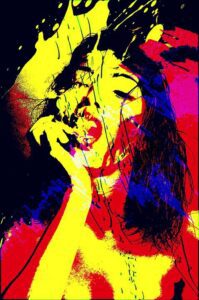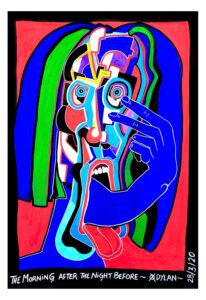British Pop Art emerged as a rebellious and vibrant movement, challenging the status quo with its bold colors and commercial imagery.
It’s a fascinating journey through the 1950s and 1960s, where artists like Richard Hamilton and Peter Blake turned the mundane into the extraordinary.
In this article, we’ll explore the iconic works that defined a generation and how british pop Art left its indelible mark on the art world.
Ready to jump into a world where art meets the Beatles and consumer culture?
Let’s unwrap the allure of British Pop art together.
Origins Of British Pop Art
The precursors to British Pop Art can be traced back to the post-war era when Europe was in rehabilitation.
It’s during this period of reconstruction that our interest in arts from all over the globe helps us understand the cultural and historical seeds of Pop Art.
Eduardo Paolozzi’s 1947 collage I was a Rich Man’s Plaything is considered to be one of the first standard bearers of this movement.
Artists of the time were exploring consumerism and media—themes that would become central to Pop Art.
Influential Gatherings
The independent group, founded in London in 1952, was a hub where artists, writers, and architects converged to discuss the potential for a new art that was reflective of contemporary society.
By intertwining popular culture with fine art, British Artists fostered a visceral connection between art and the everyday person.
They used imagery from:
- Comics,
- Advertisements,
- Celebrity culture.
As this synthesis gained momentum, so did our perception of art’s role in society.
Transforming from something traditional and elite to a more inclusive celebration of modern life.
British Pop Art carved a path for these new dynamics, setting the stage for the unification of high and low culture.
Incorporating iconic American symbols and British wit ensured the movement remained fresh and continually evolving.
Diving deeper into the movement’s growth, it’s essential to consider the socio-political climate of the 1950s and 60s.
The collective yearning for novelty fostered an environment where artists were emboldened to challenge conventions.
Our deep jump into the Genesis of British Pop Art reveals an intriguing tapestry interwoven with disdain for the aristocratic art establishment and a celebration of popular culture, laying the groundwork for a transformative artistic revolution.
Influential Artists In The Movement
As we jump into the essence of British Pop Art, it’s essential to acknowledge the artists who blazed the trail.
Richard Hamilton is a standout figure, whose collage Just what is it that makes today’s homes so different, so appealing?
is an iconic piece commonly cited as the inauguration of the movement.
Hamilton’s clever use of domestic imagery entwined with pop culture references set the stage for a new artistic discourse.
Peter Blake is another luminary, known for co-creating the album cover for the Beatles’ Sgt.
Pepper’s Lonely Hearts Club Band.
His work, characterized by the inclusion of wrestlers, film stars, and musicians, exemplifies the seamless blending of fine art with the effervescence of popular culture.
Blake’s ability to distill the exuberance of the era onto canvas encapsulates the ethos of British Pop Art.
The following artists also played pivotal roles in shaping the movement:
- David Hockney, whose paintings express a fascination with the mundane and intimate aspects of life.
- Derek Boshier, who addressed the influence of mass media with a distinctive graphic style.
- Allen Jones, renowned for his provocative fiberglass sculptures.
These artists, among others, pushed boundaries and redefined the visual language of their time.
Their work didn’t just mirror society; it engaged with cultural narratives, questioning and often satirizing the world around them.
Through bold colors, innovative materials, and a lexicon of popular imagery, they charted a course that’s still relevant in today’s art and filmmaking.
Our embrace of British Pop Art extends beyond a mere appreciation for its aesthetic; it’s a recognition of its enduring impact on visual storytelling.
Key Characteristics Of British Pop Art
We’ve witnessed how British Pop Art emerged as a revolutionary force, but what distinguishes it from other art forms?
The visually arresting characteristics of British Pop Art are integral in understanding this iconic movement.
Firstly, irony and parody were common, often as a means to critique culture.
Artists like Eduardo Paolozzi and Richard Hamilton used familiar images in unexpected contexts, prompting viewers to consider the mundane from a new perspective.
The artwork Just what is it that makes today’s homes so different, so appealing?
is a perfect illustration of this satire.
Secondly, British Pop Art stood out for its eclectic material usage.
Creators didn’t limit themselves to traditional media; they incorporated items from everyday life.
This approach not only blurred the lines between art and reality but also made art more accessible to the public.
Notably, British Pop Art was marked by:
- A celebration of popular culture: Artists embraced imagery from advertising, movies, and music. – Bold, vibrant colors: This was a signature element, making the artwork instantly recognizable and visually compelling. – An emphasis on contemporary life: The subject matter was often drawn from current events and the consumer society.
The gravitation towards screen printing was another significant hallmark.
This technique allowed for mass production of art, fitting the movement’s ethos perfectly.
David Hockney’s experimentation with screen printing helped solidify its importance within British Pop Art.
These characteristics paved the way for films and videos that challenged conventional aesthetics and narratives.

Impact And Legacy Of British Pop Art
The ripple effect of British Pop Art on visual culture can’t be overstated.

Let’s unpack how these art forms bridged the past and present, influencing various creative disciplines.
Artists like Damien Hirst and Tracey Emin are often cited as progeny of the British Pop Art movement, exemplifying the enduring potency of its themes and methodologies in contemporary art.
Their works harbor the same blend of commercial and high art that once challenged the establishment.
- Influence on Contemporary Art – Recontextualization of everyday objects – Juxtaposition of popular and fine art – Enduring use of parody and irony.
The cinematic world has absorbed these sensibilities, too.
Films such as A Clockwork Orange and Trainspotting mirror the dissection of British culture seen in Pop Art, with their graphic visual styles and subversive narratives.
Pop Art’s knack for storytelling through image continues to shape cinematic techniques.
- Influence on Filmmaking – Strong, graphic visual styles – Subversive storytelling – Cultural dissection through visuals.
The advertising industry, now brimming with Pop Art’s essence, has adopted its bold graphics and ironic twist on consumerism.
This has allowed brands to engage with audiences in a way that’s visually striking and culturally resonant—morphing advertising into an art form of its own merit.
- Influence on Advertising – Visual engagement through bold graphics – Ironic and satirical approaches – Integration of art and consumer culture.
Beyond galleries, British Pop Art has etched its signature on the very fabric of society, elevating design, fashion, and even architecture.
This cultural cornerstone has made us more attuned to the aesthetics of our everyday life, promoting a world where art isn’t confined to a canvas or a sculpture—it’s all around us.
What Is British Pop Art – Wrap Up
We’ve journeyed through the vibrant and subversive world of British Pop Art, uncovering its profound influence on culture and art.
This movement, ignited by a group of visionary artists, has left an indelible mark on contemporary art, reshaping the way we perceive the aesthetics of everyday life.
Today, we see its echoes in the works of modern creatives who continue to draw on its themes and bold visuals.
British Pop Art’s legacy is unmistakable in the realms of film, advertising, and design, proving that art isn’t confined to galleries—it’s woven into the fabric of our daily experiences.
As we embrace the world around us, let’s remember the impact of British Pop Art and its role in challenging the status quo, offering a lens through which we can view our surroundings with a renewed sense of appreciation and critique.
Frequently Asked Questions
Who Are Some Influential Artists In British Pop Art?
Richard Hamilton, Peter Blake, David Hockney, Derek Boshier, and Allen Jones are among the key figures who shaped British Pop Art.
What Are The Key Characteristics Of British Pop Art?
British Pop Art is known for its use of irony and parody, incorporation of everyday materials, bold colors, focus on popular culture, emphasis on contemporary life, and screen printing techniques.
How Did British Pop Art Critique Culture?
British Pop Art often used irony and parody to critique and challenge contemporary culture and society’s obsession with consumerism.
What Is The Impact Of British Pop Art On Contemporary Art?
British Pop Art’s legacy continues in contemporary art, influencing artists like Damien Hirst and Tracey Emin who incorporate its themes and methods into their work.

How Has British Pop Art Influenced Filmmaking?
Films like A Clockwork Orange and Trainspotting showcase the influence of British Pop Art, reflected in their graphic visual styles and subversive narratives.
What Role Did British Pop Art Play In Advertising?
British Pop Art influenced the advertising industry by introducing bold graphics and an ironic twist on consumerism, elevating advertising to a form of art.
Has British Pop Art Affected Other Industries?
Yes, British Pop Art has had a lasting impact on various industries, including design, fashion, and architecture, transforming everyday aesthetics and the perception of art in everyday life.


